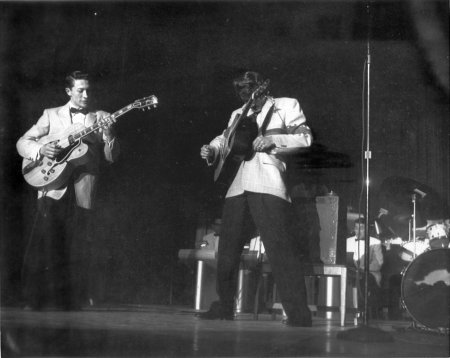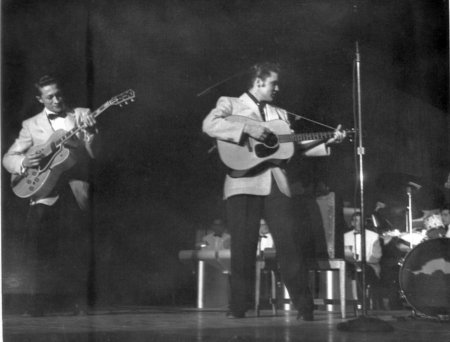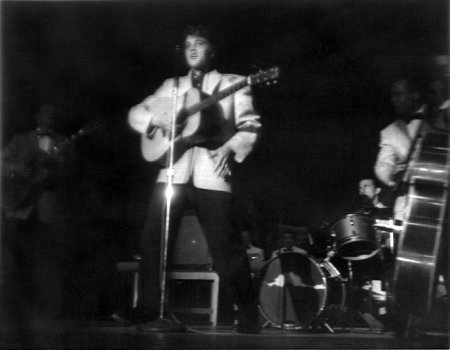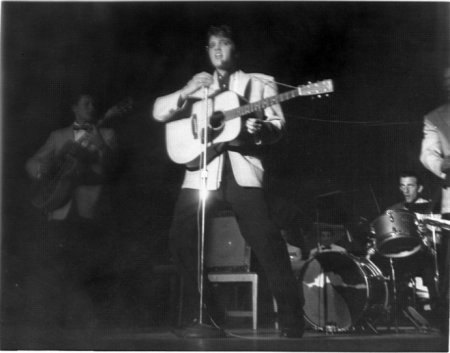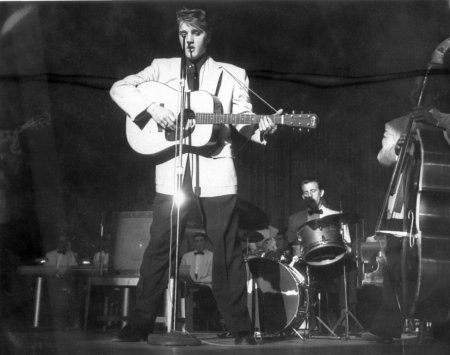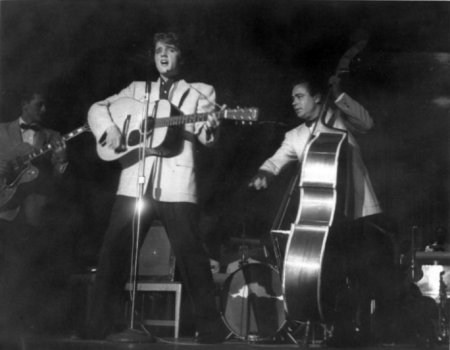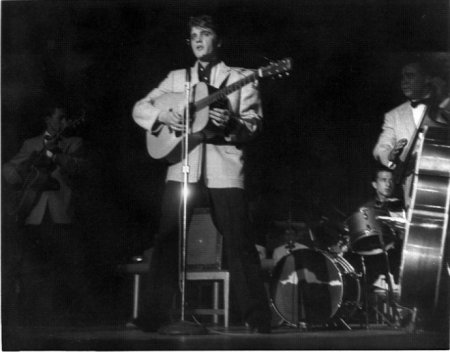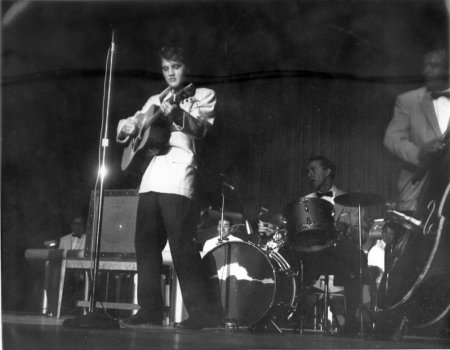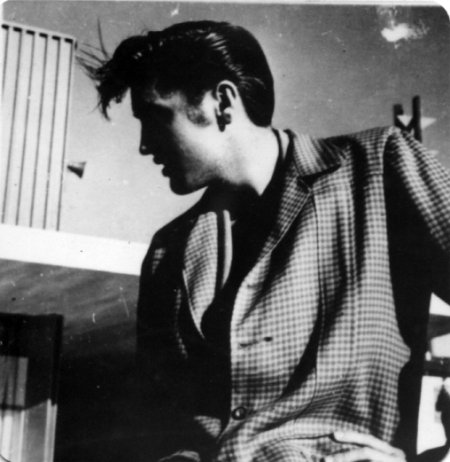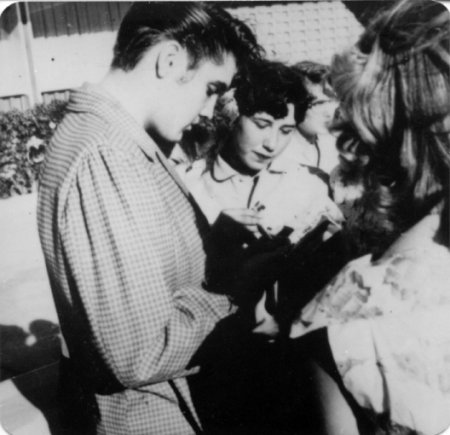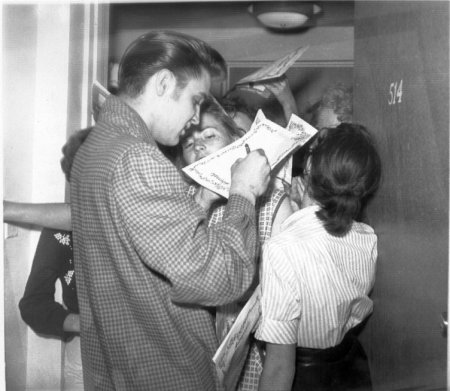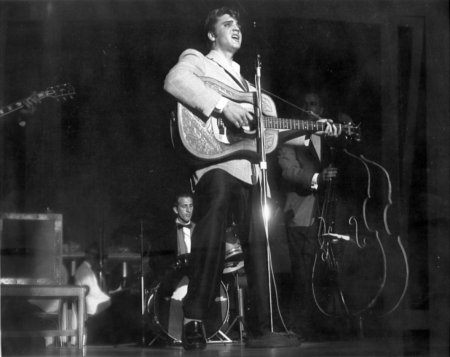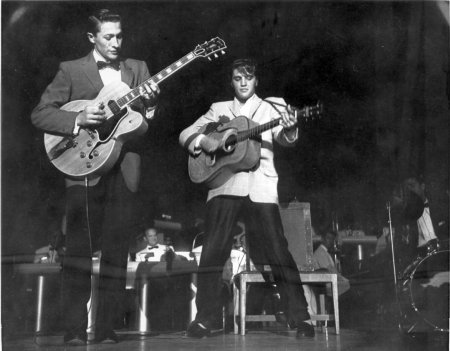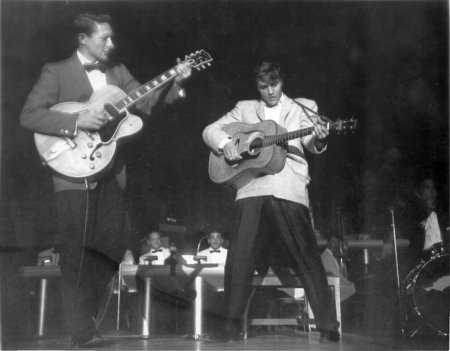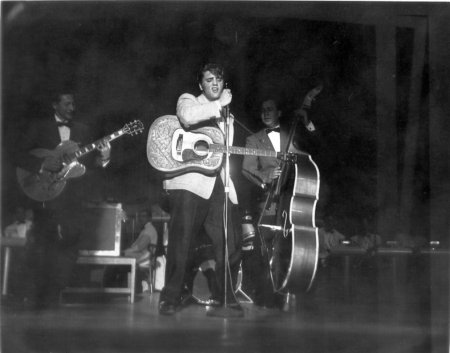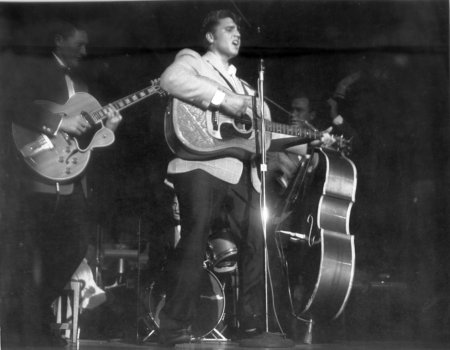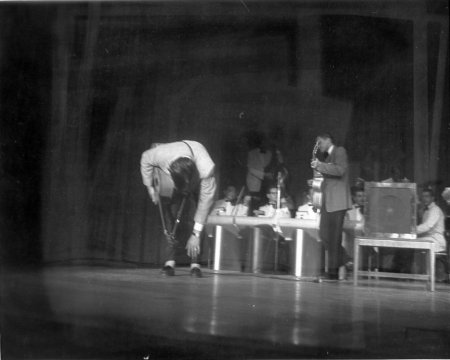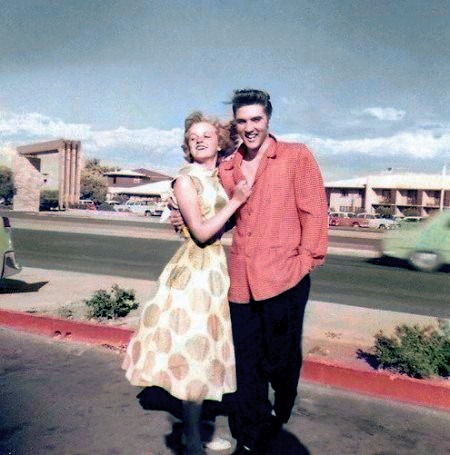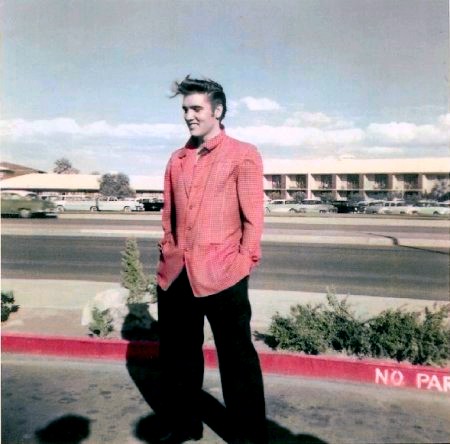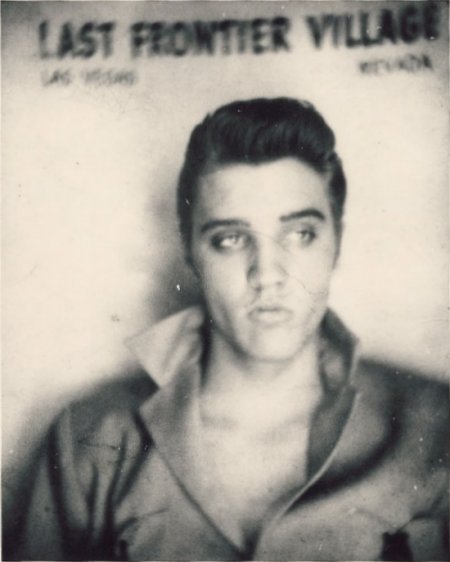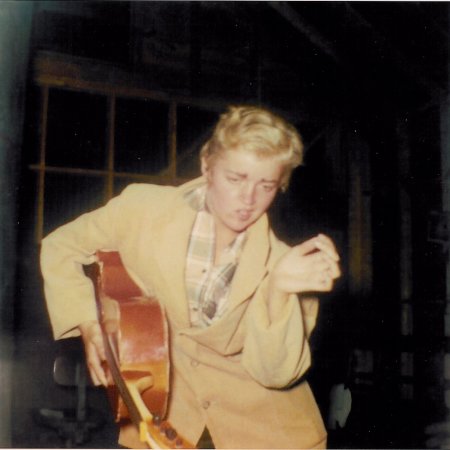 |
New Frontier Hotel Las Vegas
In 1931 gambling was legalized in the state of Nevada in an attempt to lure people to the State but Las Vegas still remained a dusty saloon town full of small-time gambling operations. In 1938, Guy McAfee, the corrupt commander of the L.A.P.D. vice squad with ties to the underworld and organized crime was forced to resign his post and flee to Las Vegas to avoid facing possible legal action. McAfee bought a small 1930’s built night club/gambling hall called the Pair-O-Dice on Highway 91 from owners Frank and Angelina Detra which was situated approximately where the north end of the Fashion Show Mall stands today. He starts calling the string of restaurants and empty desert "The Strip" after his favorite haunt, the Sunset Strip back in L.A., and in a matter of months the club is renamed the "91 Club" and becomes Las Vegas' hottest night spot.
In 1941 the 5 acre property, including the “91 Club”, was purchased by R.E. Griffith and in 1942 the Hotel Last Frontier opened. Competing with the El Rancho, the first resort on highway 91, it featured a large complex of different connected buildings and sprawling courtyards. Besides the 91 Club, the resort featured a roadside pool, 105 room hotel, small casino and bar, and a small show venue. It was the second resort to open on what would become The Las Vegas Strip. The resort offered horseback riding, BBQ’s, line dancing, and other authentic western treats. It really lived up to it’s motto – “The Early West in Modern Splendor! It played host to many performers, including a young Ronald Regan.1
In 1944, while performing at the Mount Royal Hotel in Montreal, Liberace received a phone call from Maxine Lewis, entertainment director at the Hotel Last Frontier asking him if he would be interested in playing Las Vegas. He would. She asked how much he was currently making. "Seven hundred and fifty a week," he lied. His salary was $350, but Lewis agreed to $750 per week. Liberace sized up his first-night audience, and decided to delete several of the classical pieces, concentrating on boogie-woogie and popular tunes. The audience went wild, and Maxine Lewis tore up the $750-per-week contract and gave him a new one for $1,500.2
The 1950’s brought the Last Frontier Village. The Village was a theme park of sorts, featuring a western town Main Street, shops and recreations including an old western post office, general store, a mock jail, a museum with pieces documenting the Las Vegas valley’s growth and Indian roots, as well as the now world famous Little Chapel of the West.1
The Nevada Test Site, approximately 1,375 square miles and larger than Rhode Island, is about 65 miles northwest of Las Vegas. From 1951 to 1992 the Nevada Test Site was home to 952 announced nuclear tests, and many unannounced. In the 1950s mushroom clouds from the tests were regular tourist attractions in Las Vegas where they could be seen from hotel rooms along the Strip.
In 1955, the New Frontier building was constructed on the north end of the property, partially taking over the village and forcing the chapel to make it’s first move (of many) to the southern end of the property. The New Frontier abandoned the western theme for the most part, opting for a more modern (space age) feel. The original resort remained to the south and was kept in use. The roadside pool and front foliage, however, were replaced with parking.1
Keeping with the pace of the Strip, the new building featured a sleek port cohere and a modern sign of stacked inverted cones which were indirectly lit at night, standing out in the desert sky. A new pool was built at the rear of the building to compete with the ever-growing pools of newer resorts such as the Flamingo which had opened down the road. The theater restaurant, which boasted a revolving stage, was named the Venus Room.1
The 50’s also saw the launch of many careers at the New Frontier including Elvis’ first Vegas appearance in 1956, Judy Garland’s nightclub debut, and had already given birth to Liberace’s career and staple candelabra in 1944.
In April, Colonel Parker booked Elvis, Scotty, Bill and D.J. for a two week engagement at the New Frontier beginning on April 23rd. The flyer for the Hotel advertised Freddy Martin and his orchestra, who were scheduled to do a stage show version of the Broadway musical Oklahoma! Also on the bill were comedian Shecky Greene and as an added attraction, the "Atomic Powered Singer," Elvis Presley. Since Nevada was the home of Atomic powered testing, Parker thought the name would be catchy. What Parker hadn't figured on was how an older, more sedate nightclub crowd would react to Elvis.3
On April 21, the Las Vegas Sun reported, "The handsome 21-year-old rock 'n' roller's appearance in the latest Sammy Lewis production is considered to be the Las Vegas entertainment scoop of the year. The young vocalist will be featured in one of the most lavish productions ever presented in the Venus Room, Lewis stated. Freddy Martin and his band, comic Shecky Greene, the Venus Starlets and a cast of more than 60 performers will make up the entertainment package."4
While Elvis was already becoming quite popular with teens around the country, he was not the typical Las Vegas Strip entertainer of the time and his shows were met with a cool reception. After the first performance, at which the audience politely applauded, but showed none of the wild enthusiasm to which they were accustomed, Scotty, Bill and D.J. knew they were in for a long two weeks.3
Bill Willard, a reviewer for the Las Vegas Sun newspaper, panned the performance writing, "For the teen-agers, the long, tall Memphis lad is a whiz; for the average Vegas spender or showgoer, a bore. His musical sound with a combo of three is uncouth, matching to a great extent the lyric content of his nonsensical songs."4 D.J. said, "I don't think the people there were ready for Elvis. He was mostly for teenagers, kids. We worked with Freddie Martin's orchestra and here we were three little pieces making all that noise. We tried everything we knew. Usually Elvis could get them on his side. It didn't work that time. The Colonel did a show for teenagers on Saturday, and it was just jam-packed, with everyone screaming and hollering."3
Willard may have captured the dismay that older Vegas audiences had with the young upstart, but Las Vegas resident Ed Jameson caught a vision of the future Elvis would have in Vegas. Penning a rebuttal to Willard's review, Jameson wrote, "He is not a Rock 'n' Roller nor is he a cowboy singer. He is something new coming over the horizon all by himself and he deserves his ever-growing audience. Nobody should miss him. Parents would do well to take their children to hear him. It would be a good way to get to know and understand your own kids."4
Liberace, now performing at the Riviera, attended one of the performances with his brother George. Afterwards they went backstage and they hammed it up for the press with Liberace borrowing Scotty's guitar.
On their off hours the band did pretty much what they did in any town: they hung out in the bar. None of them were interested in the casinos. One night they all went out to check out the other acts on the strip. Performing at the Sahara lounge were Freddie Bell and The Bell Boys. They had a hit in 1955 with a song titled "Hound dog" that also had been a hit for R&B singer Big Mama Thornton. When they heard them perform that night, they thought the song would be a good one for them to do for comic relief.3
"We loved the way they did it," says Scotty. "They had a piano player who stood up and played -- and the way he did his legs they looked like rubber bands bending back and forth. Jerry Leiber and Mike Stoller wrote the song for Big Mama Thornton, but Freddie and The Bell Boys had a different set of lyrics. Elvis got his lyrics from those guys. He knew the original lyrics but he didn't use them."3
According to Brian Petersen who wrote "The Atomic Powered Singer", Elvis' closing performance on May 6, 1956 was recorded and initially released on "Elvis Aron Presley," the 8-record box set released in connection with Elvis' 25th Anniversary with RCA in November 1980. (They performed "Heartbreak Hotel," "Long Tall Sally," "Blue Suede Shoes" and "Money Honey." The entire performance lasts just over 13 minutes and during it Elvis announces that Ray Bolger and Phil Silvers are in the audience. The crowd seems to enjoy his joke introduction of song titles like "Get out of the Stables Grandma you're too old to be Horsin' Around" and he asks Freddy Martin if he knows "Take back your Golden Garter, my leg is turnin' green".)* Though he would later visit often and make movies there it would be at least 13 years before Elvis would perform on stage in Las Vegas again and by then it would be without Scotty, Bill and D.J.
Elvis had signed with Hal Wallis and Paramount Pictures on April 6th, 1956. By no strange coincidence, I'm sure, during the production of Dean Martin and Jerry Lewis' last film together for Paramount, Hollywood or Bust, there was a scene outside the New Frontier that shows Elvis billed there.
The 60’s heralded the end of the Hotel Last Frontier and the Last Frontier Village. The New Frontier expanded it’s hotel to include a 7 story hotel building where the Last Frontier had stood. The addition of tennis courts, a putting green, coffee and steak houses, Olympic size pool, and additional parking updated the resort to again compete with the ever growing competition along Las Vegas Boulevard. The sign was again updated, towering 190 feet and adding and lower marquee and rotating “F” at the top. This is the sign that stands at the resort still, although the “F” no longer rotates.1
In 1967 Howard Hughes bought the property and dropped the “New” from the name. Hughes’s reign saw the addition of a second hotel tower which now formed a horseshoe around the pool and tennis courts. He also established the first computerized room reservation system in Las Vegas at the Frontier.1 Rumor had it that Suite 106, Howard Hughes' former suite, had a hidden tunnel that led to the Desert Inn.
In 1970 a live album by Diana Ross & the Supremes was recorded over the course of the group's final engagement together at the Frontier Hotel, including the final night on January 14, 1970. The show marked Diana Ross' final performance with Supremes Mary Wilson and Cindy Birdsong. At the conclusion of the show, new Supremes lead singer Jean Terrell was brought onstage and introduced to the audience.
Through the 70’s the hotel and casino crawled out of the financial hole they had slowly been sinking into over the years, and the frontier featured many more entertainers in it’s various show rooms and convention space. In 1982, Siegfried & Roy, who had gained notoriety at the neighboring Stardust Resort, opened a show at the Frontier which ran through 1988. In 1990 the resort underwent another remodel, enclosing most of the balconies on the two hotel towers and adding the 16 floor Atrium Tower where the pool house and tennis courts once stood.1
In 1991 Margaret Elardi bought resort and had many plans, but ran into some trouble with the Culinary Worker’s Union in September of that year, causing one of the longest continuous strikes in history. During the time picketers marched outside the resort and harassed patrons, both inside and out, The Hacienda, Dunes, Sands, and Landmark casinos were all closed and demolished.1
The strike ended in 1997 when Phil Ruffin purchased the resort and changed the name back to The New Frontier. The resort has undergone few changes since it's 1990 remodel, only adding different food venues and convention rooms, and also the widely flocked to Gilley’s, a country western bar with a mechanical bull and mud wrestling.1 Gilley's was a spin-off of the Texas saloon in the movie "Urban Cowboy" and was the site of the Venus Room.
In 2007 the property was purchased by a large corporation and plans were made to close and demolish the casino for yet another mega-resort on the Las Vegas strip. The 34.5 acre property that held The New Frontier and formerly the Silver Slipper casino was sold for approximately $1.2 billion. On March 16th employees were given 60 days notice that after 65 years the property would be closed for good. The casino closed it's doors at midnight on July 15th and an auction was held the following week.1 The closing of The New Frontier is bittersweet. By the end, the property lost most of it's charm. Generic coin cups, ashtrays, pens, and assorted other items replaced The New Frontier themed ones. The Atrium Tower which when opened was a beautiful sight, with flowers and plants lining every floor, had fallen into despair, and the other two hotel towers were rumored to have bedbug problems. Even still, she had a very loyal following with people returning year after year. The bingo parlor was the last on The Strip, the rooms were cheap but nicely (and sparsely) appointed. The employees were even more loyal than the guests, some having served for over 40 years.1
On November 13, 2007 at 2:30 AM the New Frontier Hotel's Atrium Tower was imploded with over 1,000 pounds of explosives before a group of reporters and bystanders to make way for a multibillion-dollar resort which is set to open in 2011. Page added November 16, 2007 1
copied or excerpted from the site
Leaving Las Vegas
site
A few more photos from the New Frontier Hotel in 1956 given to me recently from Ger J. Rijff
photos added November 9, 2008
"Singer's Kiss Leaves Girl, 13, Real Shook," read the front-page headline of April 13, 1956, in The Albuquerque Tribune. The girl in the headline was not Nancy Kozikowski but her childhood pal Carla Singer. Singer told The Trib how Presley kissed her and her friend as he was leaving the Armory in Albuquerque after a performance. Nancy Kozikowski, now an artist known internationally for her weavings, recalled, "They were sweet kisses, on the cheek, nothing over the top," she said. "Elvis was giving out autographs and the kisses were totally appropriate for the situation. " Back then, Nancy Kozikowski was Nancy Hebenstreit. She and Carla were both 13 and students at St. Vincent Academy, a Catholic school for girls. Carla's mother took them to the Presley show at the old Armory at Fifth Street and Silver Avenue Southwest. Just a few weeks after Kozikowski saw Elvis at the Armory, she accompanied her parents to a golf tournament in Las Vegas, Nev.
She said she prayed that Presley would be there. In fact, he was performing at the Frontier Hotel, across the street from where the Hebenstreits were staying.
While checking into her hotel, Kozikowski ran into a friend from Albuquerque who had a Brownie camera, so they went looking for Presley.
They found him leaving the Frontier Hotel with members of his entourage, and the accommodating star posed for pictures with them. He was 21.
One morning, Kozikowski said, she went to a penny arcade next to the Frontier Hotel and found Presley by himself, just killing time. "We took pictures in the 25-cent booth, together and alone," she said. "We also made a talking record together. I was self-conscious and silly during the recording. I said, `Hi.' He said, `Well, aren't you going to say my name.' So I said, `Hi, Elvis. What are you doing here?' "I'm too embarrassed to remember the rest." And she can't listen to it now. Kozikowski said a jealous boyfriend destroyed the record and the photo booth pictures. But the pictures from her friend's Brownie camera survive.
During the school year after her Elvis kiss, Kozikowski was among four or five girls dismissed from St. Vincent Academy.
For the talent show, she thickened her eyebrows and lips, added sideburns, combed her hair like Elvis and broadened her shoulders with one of her father's jackets. She "played" a cardboard guitar and lip-synched the words to "Heartbreak Hotel." This text was excerpted from the original article "30 years after Elvis' death, local fan's tender memories linger" by Ollie Reed Jr. published on August 16, 2007 in the Albuquerque Tribune. Nancy was kind enough give us permission to use her photos
|
|
All photos on this site (that we didn't borrow) unless otherwise indicated are the property of either Scotty Moore or James V. Roy and unauthorized use or reproduction is prohibited. |
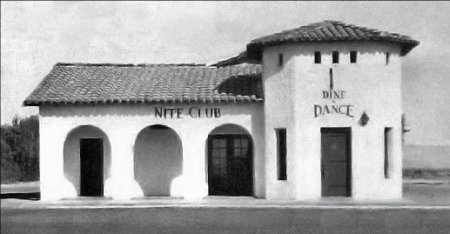
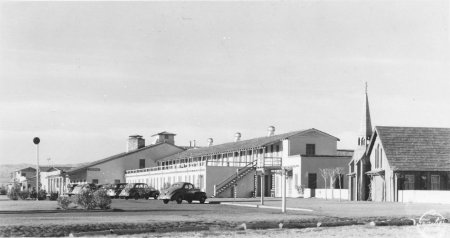
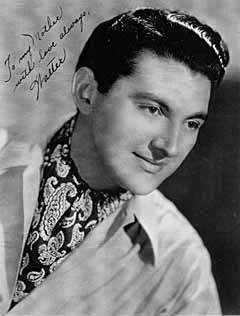
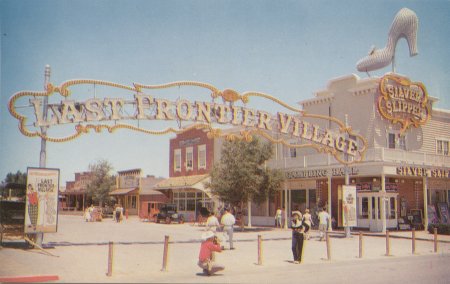
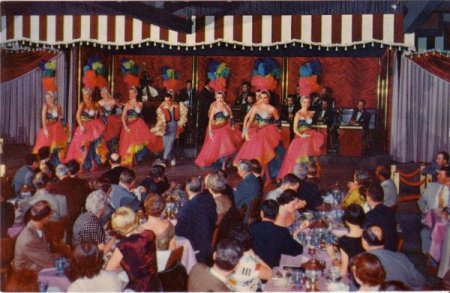
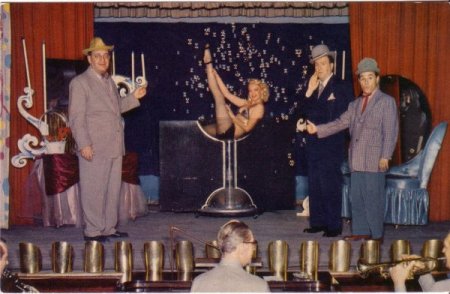
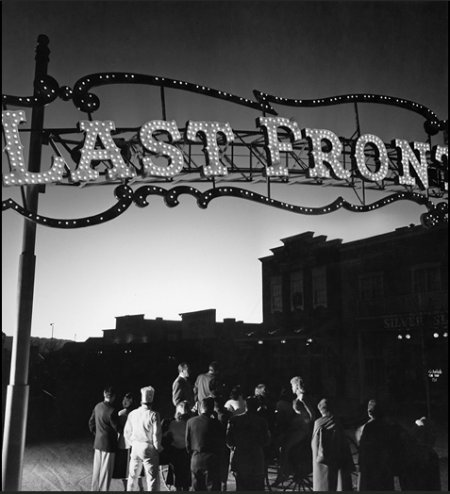

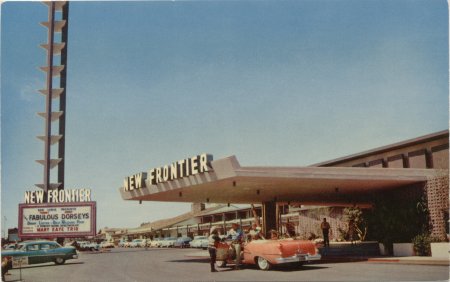
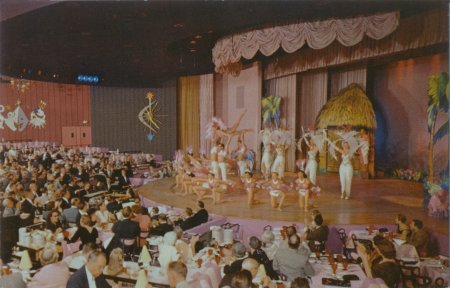

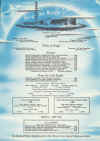
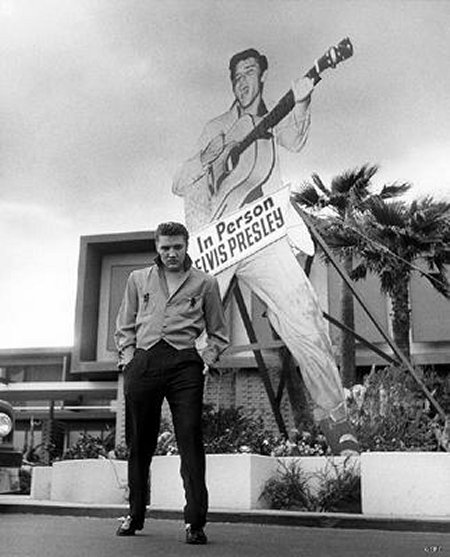
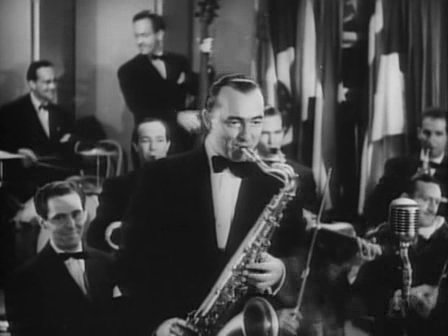
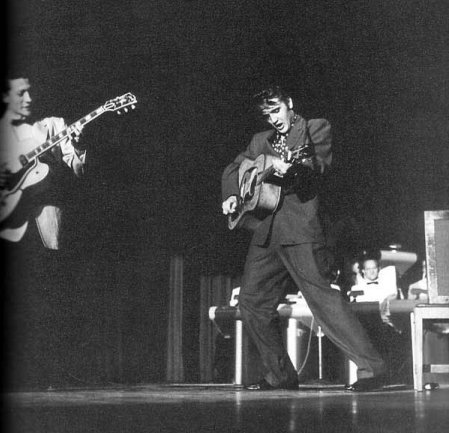
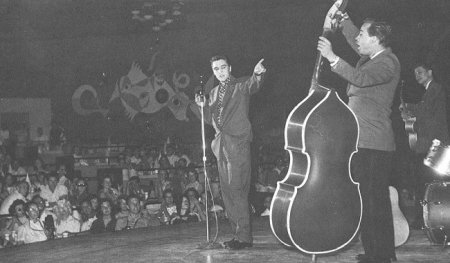

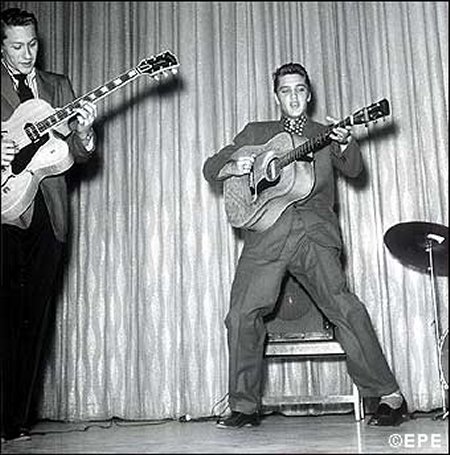
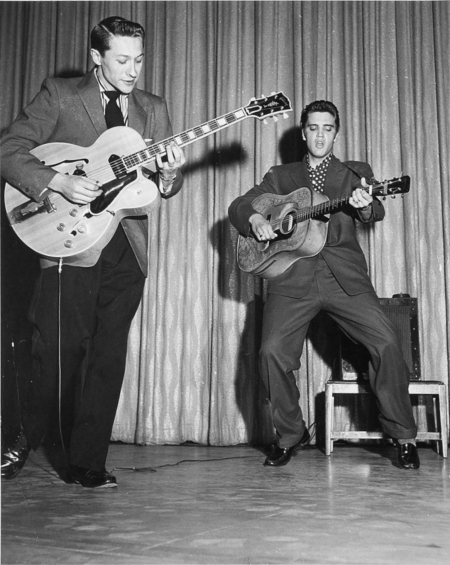
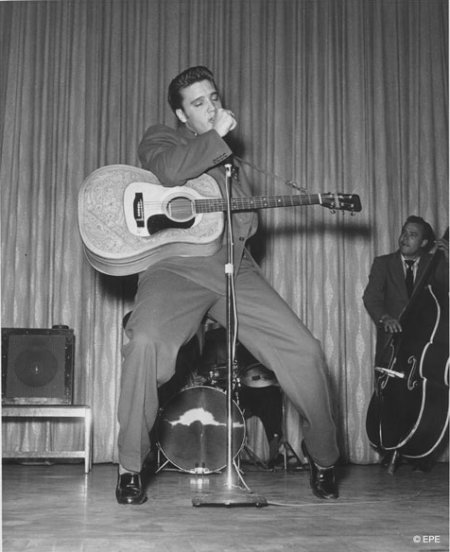
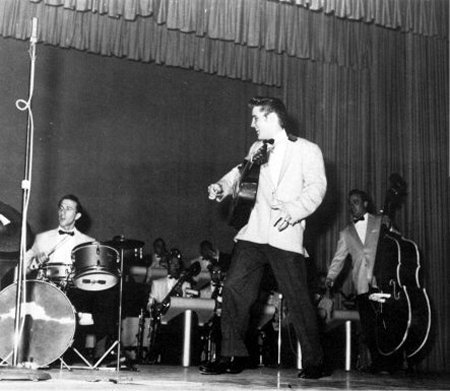
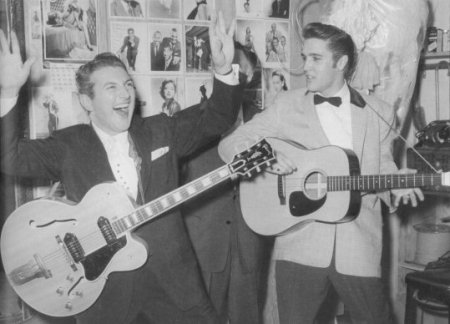
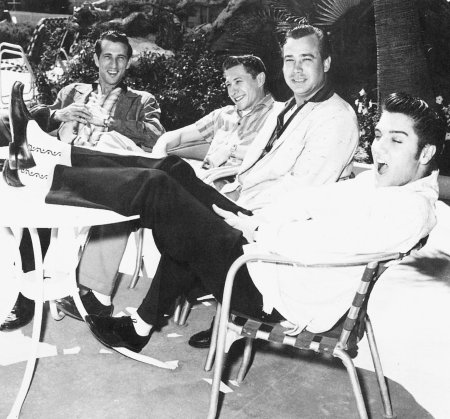
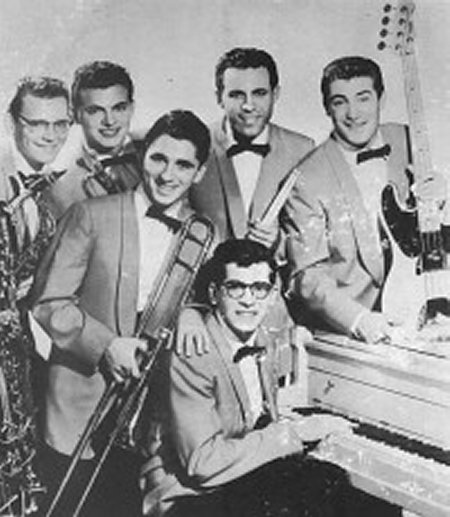
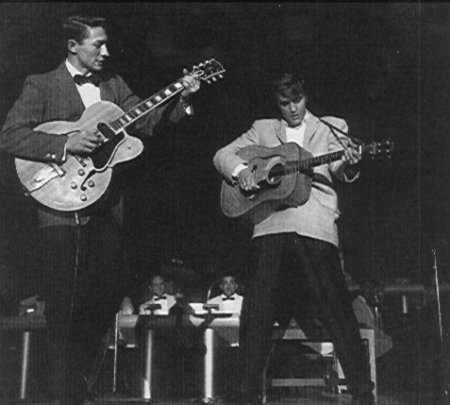
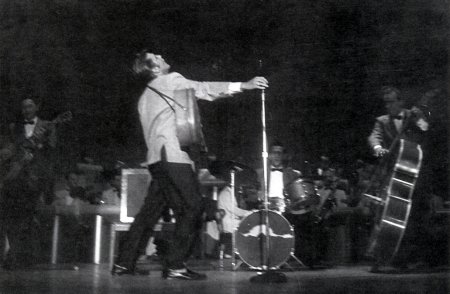
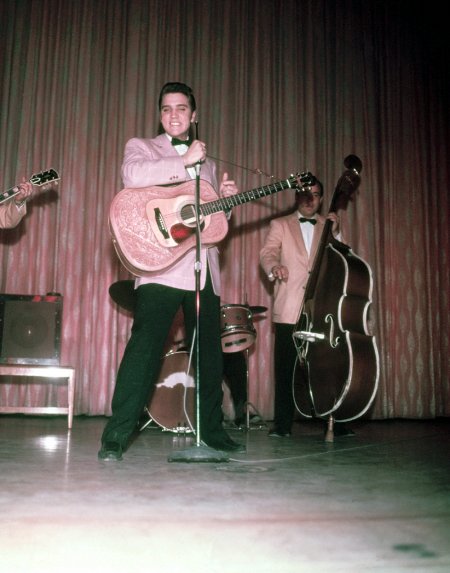
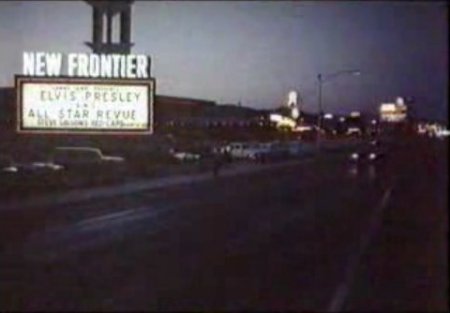
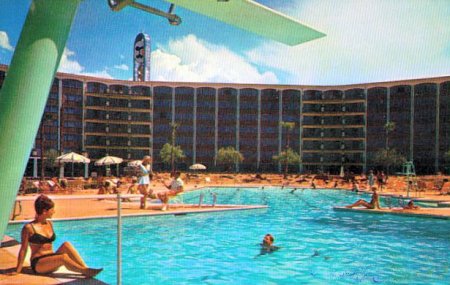
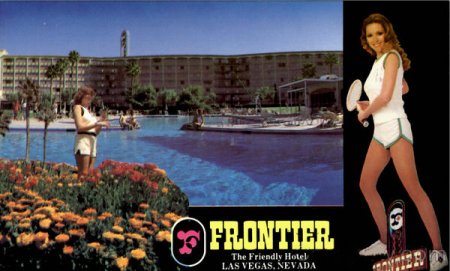
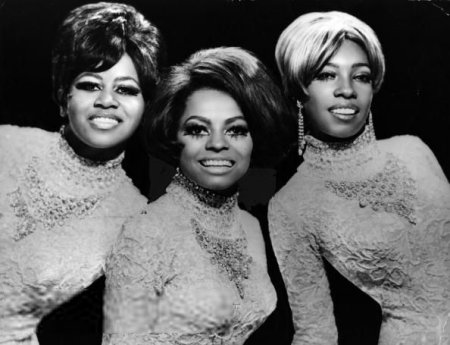
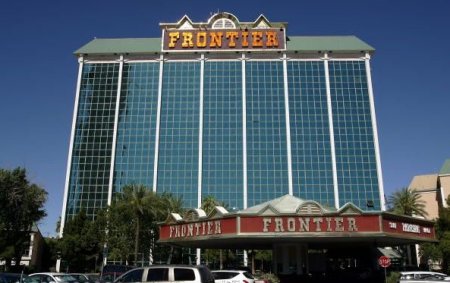
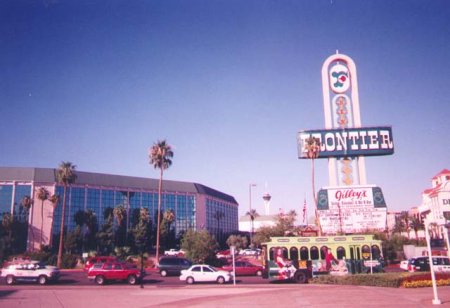
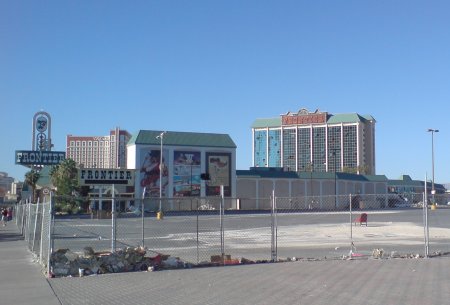
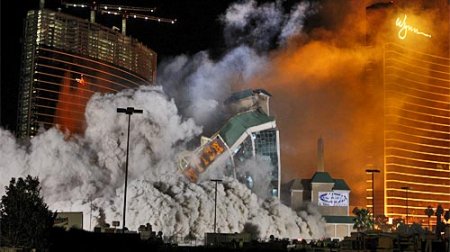
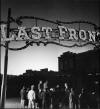 "The glow of an atomic bomb test at Yucca Flat, Nevada, 65
miles [104.6 kilometers] away, draws Las Vegas casino workers on March
17, 1953. [National Geographic magazine's] Sam Matthews
watched from a tarpaper-lined trench just two miles [3.2 kilometers]
from the explosion. 'The atomic fireball rose in the sky, a giant
sphere of orange and black, tongues of fire amid billowing soot,' he
wrote. Though this photo was probably shot for his June 1953 article
'Nevada Learns to Live With the Atom,' it has never before been
published in the magazine."
"The glow of an atomic bomb test at Yucca Flat, Nevada, 65
miles [104.6 kilometers] away, draws Las Vegas casino workers on March
17, 1953. [National Geographic magazine's] Sam Matthews
watched from a tarpaper-lined trench just two miles [3.2 kilometers]
from the explosion. 'The atomic fireball rose in the sky, a giant
sphere of orange and black, tongues of fire amid billowing soot,' he
wrote. Though this photo was probably shot for his June 1953 article
'Nevada Learns to Live With the Atom,' it has never before been
published in the magazine."
